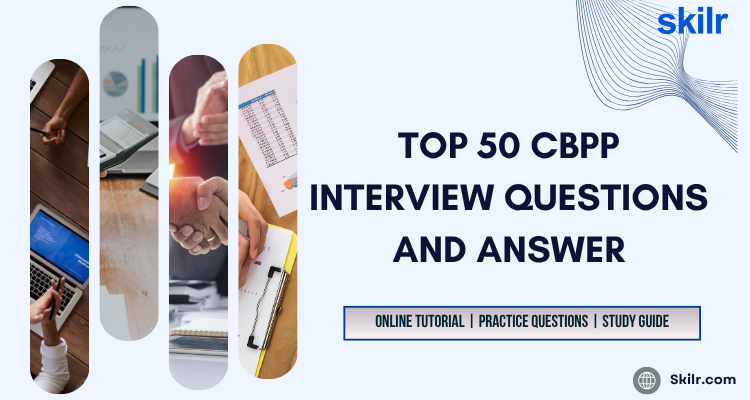The Certified Business Process Professional (CBPP) credential, administered by the Association of Business Process Management Professionals (ABPMP), represents a global standard for expertise in Business Process Management (BPM). As organizations strive for efficiency, agility, and continuous improvement, CBPP‑certified professionals are increasingly sought after to lead process redesign, governance, and optimization initiatives.
Whether you are an aspiring CBPP candidate, a business analyst, or a process manager looking to demonstrate your BPM acumen, it is crucial to articulate both foundational principles and real‑world applications during interviews. This blog presents the Top 50 CBPP Interview Questions and Answers, carefully organized from basic BPM concepts through advanced methodologies and scenario‑based challenges. Use this guide to reinforce your knowledge, practice clear explanations, and gain the confidence needed to ace your next CBPP‑focused interview.
Who Should Read This Blog?
This guide is crafted for professionals and aspirants aiming to excel in CBPP‑related roles and interviews. You will benefit if you are:
- An aspiring CBPP candidate preparing for the ABPMP certification exam and job interviews
- A business analyst, process manager, or BPM consultant seeking to validate your process expertise
- A BPM practitioner looking to refresh core concepts, methodologies, and governance practices
- An HR or hiring manager who wants to benchmark candidates’ CBPP knowledge
- Anyone involved in process improvement, process modeling, or enterprise transformation
Let’s begin with the Basic-Level Questions to ensure a solid grounding in BPM fundamentals.
Basic-Level CBPP Interview Questions and Answers (1–15)
- What is Business Process Management (BPM)?
Answer:
Business Process Management is the discipline of designing, modeling, executing, monitoring, and optimizing an organization’s processes to achieve strategic objectives and operational efficiency. - What does CBPP stand for, and why is it important?
Answer:
CBPP stands for Certified Business Process Professional. It validates mastery of the ABPMP Body of Knowledge (CBOK) and equips practitioners to lead BPM initiatives using industry best practices. - What are the key phases of the BPM lifecycle?
Answer:- Design: Document current (“as‑is”) processes and define future (“to‑be”) states
- Model: Create detailed process diagrams (e.g., BPMN)
- Execute: Deploy the process manually or via automation
- Monitor: Track performance with KPIs and dashboards
- Optimize: Identify and implement continuous improvements
- Who is a process owner?
Answer:
A process owner is the individual accountable for a process’s performance, governance, and continuous improvement. - What is the difference between a process map and a process model?
Answer:- A process map provides a high‑level overview of steps and handoffs.
- A process model offers a detailed representation, including activities, decision points, and data flows.
- Name three common process modeling notations.
Answer:- BPMN 2.0 (Business Process Model and Notation)
- Event‑Driven Process Chains (EPC)
- UML Activity Diagrams
- What is process capability?
Answer:
Process capability measures a process’s ability to produce outputs within specified limits, often expressed via metrics like Cp and Cpk. - What does SIPOC stand for, and when is it used?
Answer:
SIPOC stands for Suppliers, Inputs, Process, Outputs, Customers. It’s used early in process discovery to define scope and context. - Explain “as‑is” vs. “to‑be” analysis.
Answer:- As‑Is Analysis: Examines the current process to identify gaps.
- To‑Be Analysis: Designs an improved future process incorporating best practices.
- What is process governance?
Answer:
Process governance is the framework of roles, policies, and controls that ensures processes are managed consistently and meet compliance requirements. - What is a RACI matrix?
Answer:
A RACI matrix assigns who is Responsible, Accountable, Consulted, and Informed for each process activity. - What is stakeholder analysis in BPM?
Answer:
Stakeholder analysis identifies individuals or groups affected by a process, ensuring their needs and concerns are addressed. - What are Key Performance Indicators (KPIs) in BPM?
Answer:
KPIs are quantifiable metrics—such as cycle time, error rate, and throughput—used to assess process performance. - What is process standardization?
Answer:
Process standardization establishes uniform procedures and best practices across the organization to ensure consistency and quality. - How does CBPP certification benefit a BPM career?
Answer:
It validates BPM expertise, enhances professional credibility, and opens opportunities in process leadership, consulting, and governance.
Intermediate-Level CBPP Interview Questions and Answers (16–30)
- Explain the Six Sigma DMAIC methodology.
Answer:- Define: Identify the problem and project goals
- Measure: Collect data and determine current performance baselines
- Analyze: Identify root causes of defects or inefficiencies
- Improve: Develop and implement solutions
- Control: Monitor the improved process to sustain gains
- How do you prioritize process improvement initiatives?
Answer:
By evaluating each initiative against criteria such as business impact, cost, risk, alignment with strategic objectives, and ease of implementation—often using a weighted scoring model. - What is process gap analysis?
Answer:
A comparison between “as‑is” and “to‑be” process models to identify deficiencies, inefficiencies, or missing controls, forming the basis for targeted improvements. - Describe value stream mapping.
Answer:
A Lean technique that visualizes all steps—from raw input to customer delivery—highlighting value‑added versus non‑value‑added activities to eliminate waste. - How do you model decision points in a process?
Answer:
Using gateways in BPMN (Exclusive, Parallel, Inclusive) or decision diamonds in flowcharts, each labeled with conditions that determine the subsequent path. - What is a swimlane diagram, and when is it used?
Answer:
A process flow organized into “lanes” representing actors, departments, or systems—clarifying responsibilities and handoffs in cross‑functional processes. - Define process automation and its benefits.
Answer:
The use of technology (RPA, BPM suites) to execute repetitive tasks automatically, reducing errors, cycle times, and operational costs while improving consistency. - How do you manage exceptions or deviations in a process?
Answer:
By defining clear exception‑handling paths in the model, automated alerts or manual reviews, and root‑cause analysis to adjust the process as needed. - What comprises a BPM governance framework?
Answer:
Policies, standards, roles (owners, stewards), decision rights, performance metrics, and continuous oversight mechanisms to ensure process integrity and alignment. - How do you measure process performance?
Answer:
By establishing relevant KPIs (e.g., cycle time, throughput, error rate), collecting data via dashboards or reports, and analyzing trends against targets. - What is process benchmarking?
Answer:
Comparing process performance against industry best practices or peer organizations to identify improvement opportunities and set aspirational goals. - How do you capture process requirements?
Answer:
Through stakeholder interviews, workshops, document reviews, and observation—then translating findings into user stories, use cases, or requirement specifications. - Name three popular process modeling tools.
Answer:- ARIS
- Signavio
- Bizagi Modeler
- Explain change control in process management.
Answer:
A structured approach for submitting, evaluating, approving, and tracking changes to processes—ensuring consistency, compliance, and traceability. - How do you ensure process compliance?
Answer:
By integrating automated controls, regular audits, training, and monitoring dashboards that flag deviations for prompt corrective action.
Advanced-Level CBPP Interview Questions and Answers (31–40)
- What is Continuous Process Improvement (CPI)?
Answer: Continuous Process Improvement is an ongoing effort to enhance products, services, or processes over time by making small, incremental improvements, often leveraging methodologies like PDCA (Plan‑Do‑Check‑Act) and Lean principles. - How do you assess process maturity, and what is CMMI?
Answer: Process maturity is evaluated against defined levels (from ad hoc to optimized) using frameworks like the Capability Maturity Model Integration (CMMI), which provides best‑practice guidelines for process improvement. - Describe process risk assessment.
Answer: Process risk assessment involves identifying potential risks (operational, compliance, quality), analyzing their likelihood and impact, and implementing mitigation controls within the process design and governance. - What is process architecture?
Answer: Process architecture is the hierarchical organization of an enterprise’s end‑to‑end processes, sub‑processes, and activities—providing a blueprint that aligns processes with strategic objectives and capabilities. - Explain the Balanced Scorecard in a BPM context.
Answer: The Balanced Scorecard is a strategic performance management tool that tracks KPIs across four perspectives—Financial, Customer, Internal Process, and Learning & Growth—to ensure holistic process performance alignment with strategy. - What is process simulation, and when is it used?
Answer: Process simulation uses software to model and analyze process behavior under varying conditions, enabling “what‑if” analysis for capacity planning, bottleneck identification, and resource optimization before implementation. - How do you scale BPM governance across an enterprise?
Answer: By establishing standardized policies, a centralized Center of Excellence (CoE), role‑based training, and automated monitoring—while allowing for local adaptations within global governance frameworks. - What is process mining, and how does it add value?
Answer: Process mining analyzes event logs from IT systems to automatically reconstruct “as‑is” process flows, revealing deviations, bottlenecks, and compliance issues—facilitating data‑driven improvement. - How do you calculate process Return on Investment (ROI)?
Answer: ROI = (Benefits – Costs) / Costs. Benefits include cost savings, productivity gains, and revenue enhancements from process improvements; costs cover implementation, technology, and training. - How do you integrate BPM with enterprise systems like ERP or CRM?
Answer: By leveraging APIs, middleware (ESB), and BPM suites that connect to systems via connectors or web services—ensuring seamless data flow, end‑to‑end process automation, and real‑time monitoring.
Scenario-Based CBPP Interview Questions and Answers (41–50)
- A critical process consistently misses its service‑level agreements (SLAs). How would you address this?
Answer:- Analyze KPI data to identify where and why SLAs are breached (e.g., specific steps, times, or resources).
- Conduct root‑cause analysis (e.g., fishbone, 5 Whys).
- Redesign or reallocate resources for the problematic step—consider automation or parallelization.
- Update process controls and monitoring to detect SLA slippage early.
- Implement continuous feedback loops to adjust and sustain improvements.
- How would you model a cross‑functional approval process?
Answer:- Identify involved roles (e.g., requester, approver, finance).
- Use BPMN to diagram tasks, gateways for approval/rejection, and swimlanes for each function.
- Define data artifacts and deadlines.
- Add exception paths for escalations and notifications.
- Validate with stakeholders and refine.
- An upcoming merger requires harmonizing two different process frameworks. What is your approach?
Answer:- Inventory both sets of processes and frameworks.
- Map common and unique processes.
- Define a unified target framework, selecting best practices from each.
- Conduct gap analysis and impact assessment.
- Plan phased rollout with change management, training, and governance updates.
- How do you implement process changes without disrupting ongoing operations?
Answer:- Pilot changes in a controlled environment or subset of users.
- Use parallel runs (“shadow mode”) comparing old vs. new process outputs.
- Gather feedback and address issues before full deployment.
- Roll out incrementally with clear communication and support.
- Monitor performance closely and be ready to rollback if needed.
- Describe how you would design a process dashboard for executive leadership.
Answer:- Identify executive KPIs (cycle time, cost savings, customer satisfaction).
- Use high-level visuals: scorecards, trend charts, and heat maps.
- Provide drill‑down capabilities for deeper analysis.
- Ensure data freshness with real-time or scheduled updates.
- Keep layout uncluttered and annotate insights or action items.
- A process owner is disengaged and unresponsive. How would you re‑engage them?
Answer:- Schedule a one‑on‑one to understand concerns or workload issues.
- Highlight the process’s strategic impact and their role’s importance.
- Offer support—delegate tasks or provide resources.
- Set clear, achievable milestones and celebrate early successes.
- Establish regular check‑ins and involve them in governance discussions.
- How do you ensure data integrity in automated workflows?
Answer:- Implement validation rules and checkpoints within the automation.
- Use transactional operations that rollback on errors.
- Log all data changes with timestamps and user/process identifiers.
- Periodically audit logs and reconcile against source systems.
- Incorporate exception handling routines for manual review.
- How would you manage a global process spanning multiple time zones and cultures?
Answer:- Model handoffs with explicit time‑zone awareness and SLAs.
- Leverage 24/7 support teams and overlapping shifts.
- Use centralized BPM tools with role‑based access.
- Localize documentation and training materials.
- Monitor performance by region and adjust workflows for cultural nuances.
- A process automation project failed to deliver expected benefits. What lessons would you draw and next steps?
Answer:- Conduct a post‑implementation review to compare objectives vs. outcomes.
- Identify root causes (e.g., poor requirements, inadequate testing, change management gaps).
- Reassess stakeholder alignment and communication strategies.
- Redefine success criteria and refine the automation design.
- Implement improvements via a controlled pilot before wider rollout.
- How do you approach continuous improvement after initial process optimization?
Answer:- Establish ongoing performance monitoring with real‑time dashboards.
- Solicit regular feedback from process participants and stakeholders.
- Schedule periodic reviews to identify new bottlenecks or opportunities.
- Maintain a backlog of improvement ideas and prioritize based on impact.
- Embed a culture of experimentation and learning—use small, iterative changes guided by data.
Core CBPP/BPM Concepts to Revise Before an Interview
Before stepping into your CBPP interview, it’s essential to be fluent not only in BPM terminology but also in the practical frameworks and tools that underpin effective process management. Below are the key areas you should be able to discuss confidently:
1. The BPM Lifecycle and Methodologies
Familiarize yourself with each phase of the BPM lifecycle—Design, Model, Execute, Monitor, and Optimize—and understand how they interlock to drive continuous improvement. Be prepared to explain how Lean principles (eliminating waste), Six Sigma (the DMAIC methodology), and PDCA (Plan–Do–Check–Act) can be applied within these phases to achieve process excellence.
2. Process Modeling Techniques and Notations
Know how to use BPMN 2.0 to diagram events, tasks, gateways, and message flows. You should also be comfortable creating SIPOC diagrams to define high‑level scope and employing Value Stream Mapping to identify and reduce non‑value‑added steps. Being able to choose the right notation for the right audience is a hallmark of a skilled process professional.
3. Governance, Roles, and Accountability
Review the distinctions between Process Owner, Process Steward, and the BPM Center of Excellence. Explain how RACI matrices clarify responsibilities—who is Responsible, Accountable, Consulted, and Informed—and describe the role of change control boards in maintaining process integrity and version control.
4. Performance Measurement and KPIs
Articulate how to select and track Key Performance Indicators—such as cycle time, throughput, and error rate—to gauge process health. Be ready to discuss the Balanced Scorecard framework and how it balances financial, customer, internal, and learning perspectives. You may also reference benchmarking practices to set realistic performance targets.
5. Continuous Improvement and Maturity Models
Demonstrate your understanding of how CMMI maturity levels reflect an organization’s BPM sophistication, and explain how techniques like process mining uncover the “as‑is” reality from event logs. Highlight how PDCA cycles and Kaizen events enable iterative gains and foster a culture of ongoing refinement.
6. Process Governance Frameworks
Explain how policies, standards, and audit mechanisms work together to enforce compliance and quality. Discuss how well‑defined roles and decision rights prevent ambiguity, and how clear exception‑handling and escalation paths keep processes resilient in the face of disruptions.
7. Tools and Technologies
Know at least one leading process‑modeling tool—such as ARIS, Signavio, or Bizagi—and understand how it supports collaboration and versioning. Be ready to mention automation platforms (e.g., Camunda, IBM BPM) and RPA solutions (UiPath, Automation Anywhere), as well as analytics and dashboarding tools like Power BI or Tableau for monitoring process performance.
8. Change Management and Stakeholder Engagement
Emphasize the importance of stakeholder analysis and communication planning to secure buy‑in. Describe how training programs, documentation, and readiness assessments smooth the transition to new processes, and how you would address resistance through effective engagement strategies.
9. Integration and Automation Strategies
Discuss techniques for integrating BPM solutions with enterprise systems—such as ERP or CRM platforms—using APIs or middleware. Explain how to balance automated workflows with human tasks, and outline approaches for robust exception and error handling.
10. Building a Business Case and Measuring ROI
Finally, be ready to demonstrate how you calculate the return on investment for process initiatives—comparing cost savings, productivity gains, and payback periods. Show how executive dashboards and scorecards validate ongoing benefits and keep leadership aligned with process objectives.
Conclusion
Achieving the CBPP designation and excelling in BPM roles requires more than just theoretical knowledge—it demands practical expertise in modelling, governance, continuous improvement, and stakeholder management. This guide’s 50 questions span foundational definitions, methodological frameworks, advanced analytics, and real‑world scenarios, providing a comprehensive roadmap for your interview preparation.
With this blend of knowledge and real‑world insight, you’ll be well‑equipped to showcase your capabilities and secure your next role as a Certified Business Process Professional.





